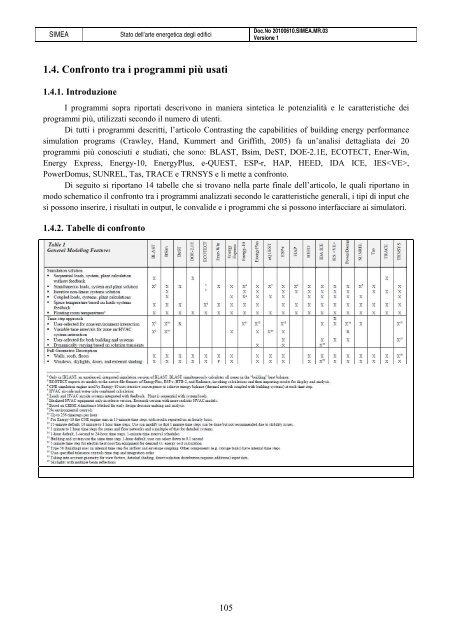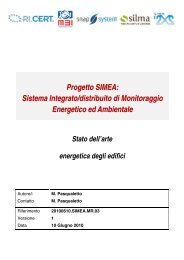Progetto SIMEA - Automatica - Università degli Studi di Padova
Progetto SIMEA - Automatica - Università degli Studi di Padova
Progetto SIMEA - Automatica - Università degli Studi di Padova
You also want an ePaper? Increase the reach of your titles
YUMPU automatically turns print PDFs into web optimized ePapers that Google loves.
<strong>SIMEA</strong> Stato dell’arte energetica <strong>degli</strong> e<strong>di</strong>fici<br />
1.4. Confronto tra i programmi più usati<br />
1.4.1. Introduzione<br />
105<br />
Doc.No 20100610.<strong>SIMEA</strong>.MR.03<br />
Versione 1<br />
I programmi sopra riportati descrivono in maniera sintetica le potenzialità e le caratteristiche dei<br />
programmi più, utilizzati secondo il numero <strong>di</strong> utenti.<br />
Di tutti i programmi descritti, l’articolo Contrasting the capabilities of buil<strong>di</strong>ng energy performance<br />
simulation programs (Crawley, Hand, Kummert and Griffith, 2005) fa un’analisi dettagliata dei 20<br />
programmi più conosciuti e stu<strong>di</strong>ati, che sono: BLAST, Bsim, DeST, DOE-2.1E, ECOTECT, Ener-Win,<br />
Energy Express, Energy-10, EnergyPlus, e-QUEST, ESP-r, HAP, HEED, IDA ICE, IES,<br />
PowerDomus, SUNREL, Tas, TRACE e TRNSYS e li mette a confronto.<br />
Di seguito si riportano 14 tabelle che si trovano nella parte finale dell’articolo, le quali riportano in<br />
modo schematico il confronto tra i programmi analizzati secondo le caratteristiche generali, i tipi <strong>di</strong> input che<br />
si possono inserire, i risultati in output, le convalide e i programmi che si possono interfacciare ai simulatori.<br />
1.4.2. Tabelle <strong>di</strong> confronto
















